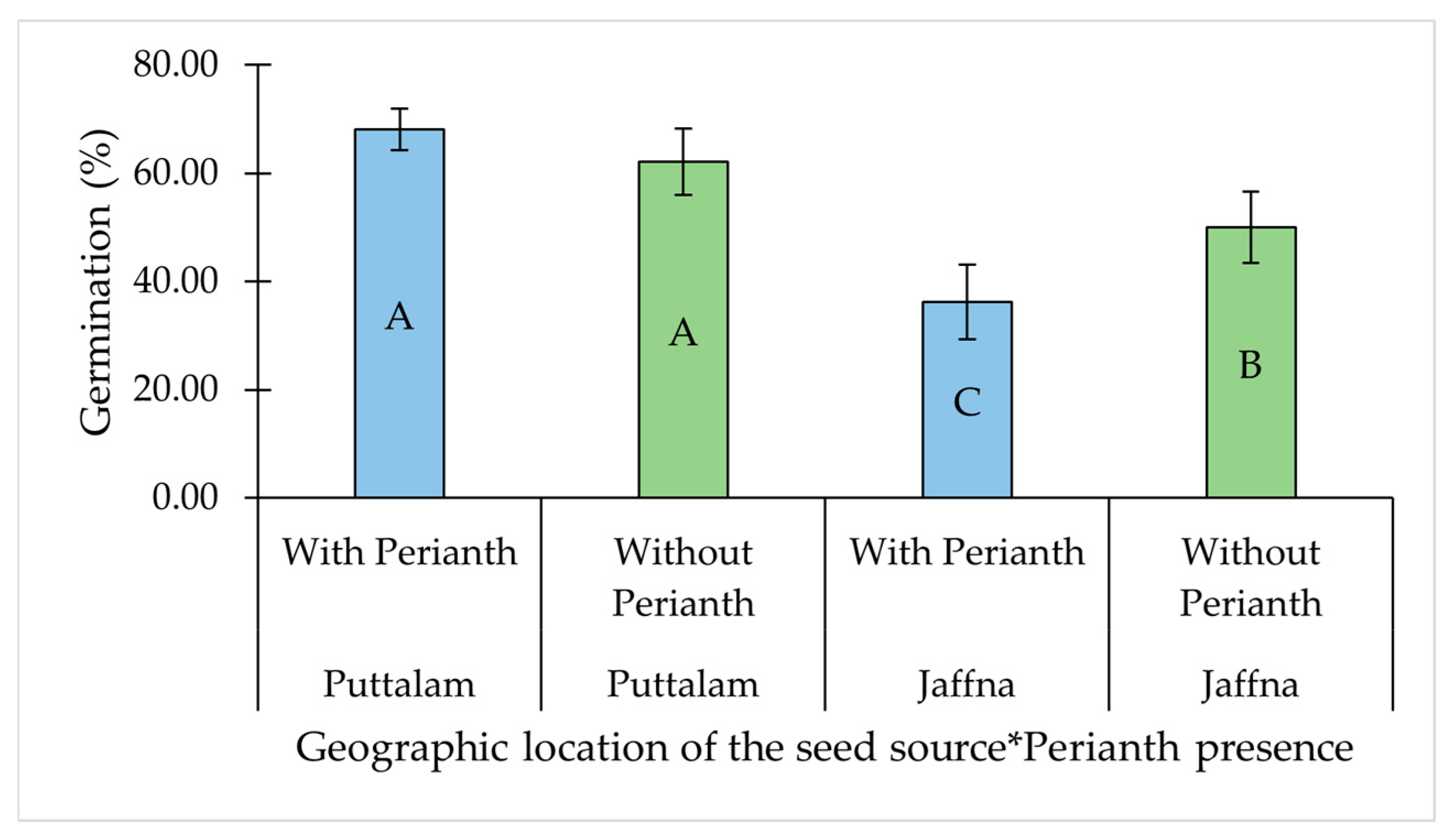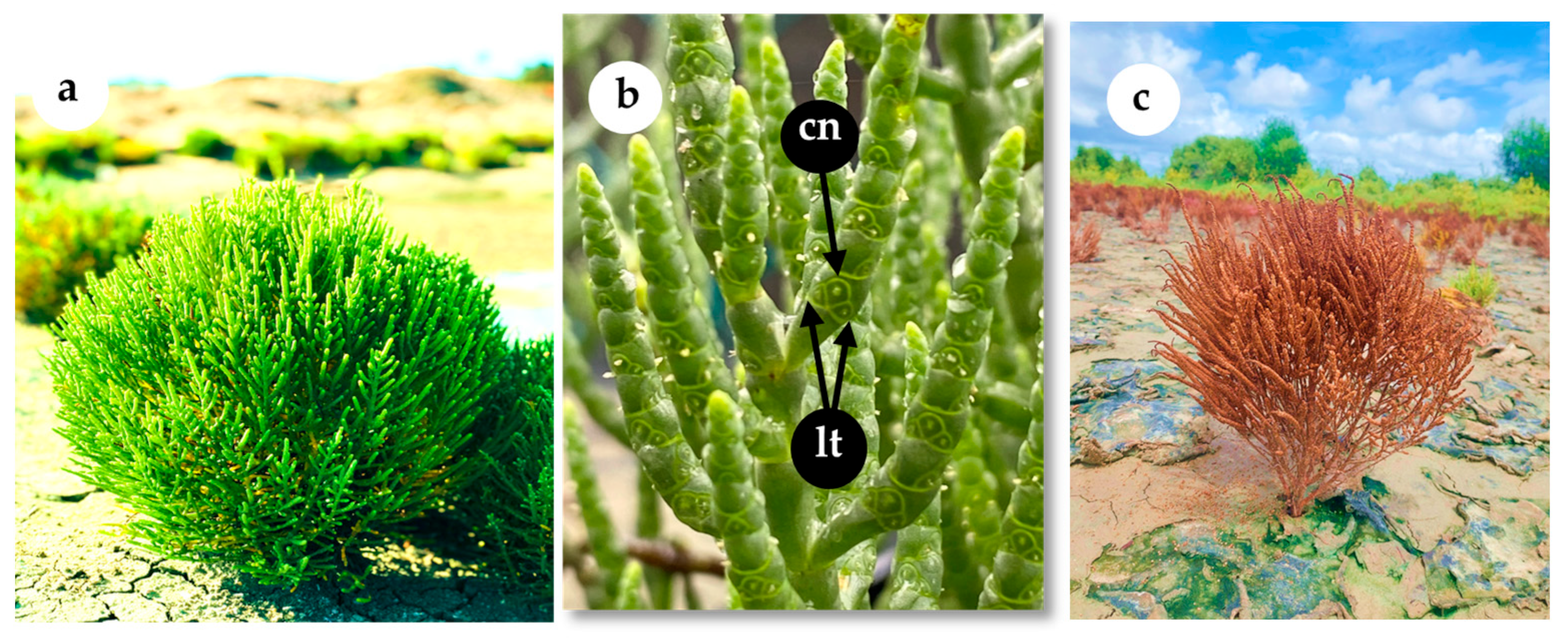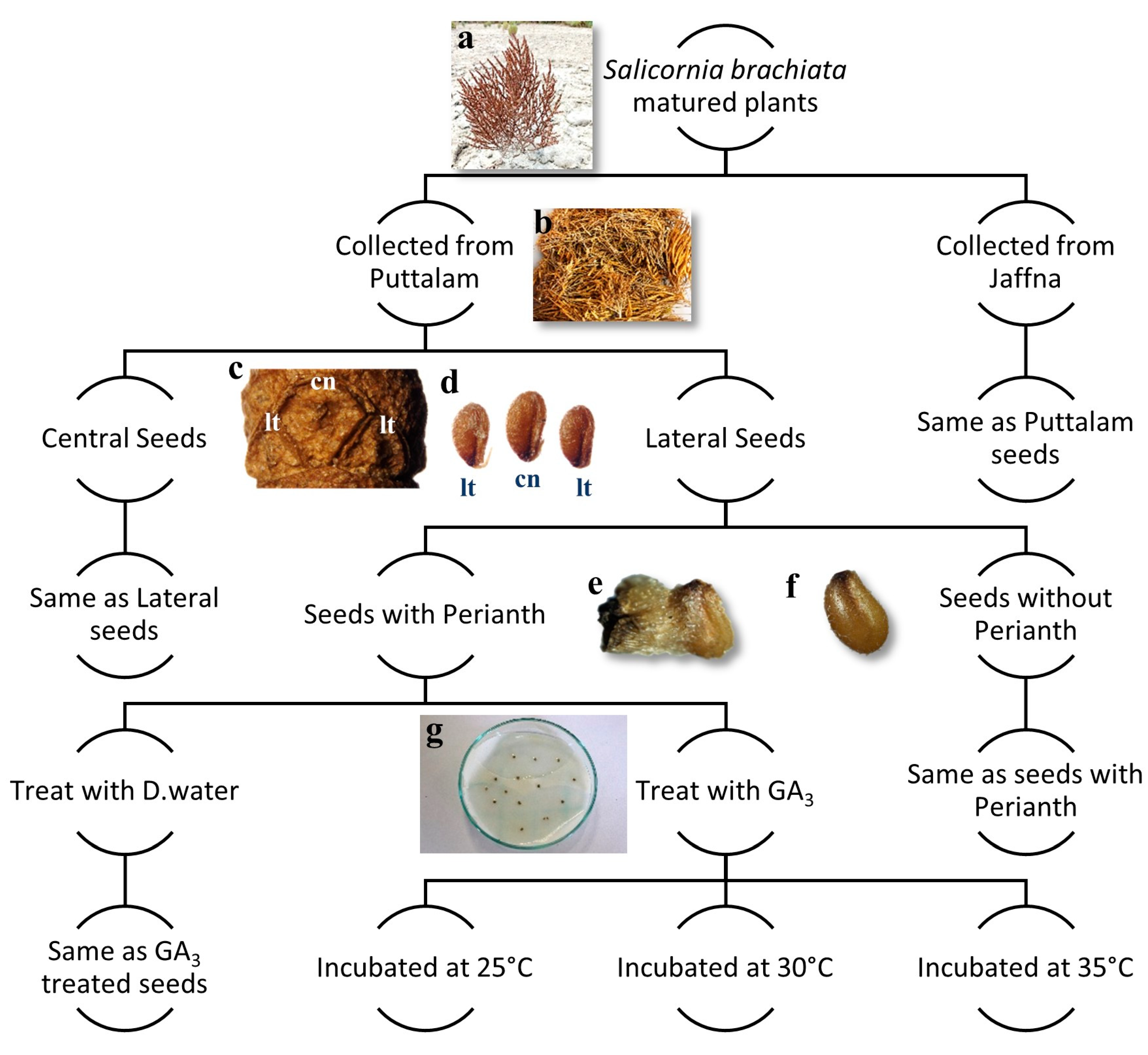Seed Dormancy and Germination Responses of Salicornia brachiata: Towards Sustainable Cultivation and Conservation in Saline Habitats
Abstract
1. Introduction
2. Results
2.1. Individual Effects of Temperature, Perianth Presence, Seed Type, Chemical Treatment and Geographic Location of the Seed Source on the Seed Germination Percentage of S. brachiata
2.2. Interaction Effects of Temperature, Perianth Presence, Seed Type, Chemical Treatment and Geographic Location of the Seed Source on Seed Germination Percentage of S. brachiata
3. Discussion
4. Materials and Methods
4.1. Seed Collection
4.2. Germination Experiment
4.3. Data Analysis
5. Conclusions
Supplementary Materials
Author Contributions
Funding
Data Availability Statement
Conflicts of Interest
References
- Ekanayake, S.; Egodawatta, C.; Attanayake, R.N.; Perera, D. From Salt Pan to Saucepan: Salicornia, a Halophytic Vegetable with an Array of Potential Health Benefits. Food Front. 2023, 4, 641–676. [Google Scholar] [CrossRef]
- Jayasundara, Y.; Herath, N.; Buddhipala, A.; Bandara, M.D.; Jayasinghe, L.; Attanayake, R.; Perera, D.; Paranagama, P. Nutritional Composition and Bioactive Properties of Salicornia brachiata: A Comparison of Drying Methods. Nat. Prod. Commun. 2025, 20, 1934578X251315822. [Google Scholar] [CrossRef]
- Rao, G.N.; Murty, P.P. Morphological and Anatomical Features of Salicornia brachiata Roxb. J. Biol. Chem. Res. 2013, 30, 887–891. [Google Scholar]
- Patel, S. Salicornia: Evaluating the Halophytic Extremophile as a Food and a Pharmaceutical Candidate. 3 Biotech 2016, 6, 104. [Google Scholar] [CrossRef]
- Siridewa, K.; De Silva, W.; Ratnayake, R.M.C.S.; Wijesundara, S.; Perera, D.; Attanayake, R.N. Species Identification and Pollination Biology of an Economically Important True Halophyte, Salicornia brachiata Roxb. Aquat. Bot. 2025, 196, 103827. [Google Scholar] [CrossRef]
- Rathore, A.P.; Chaudhary, D.R.; Jha, B. Biomass Production, Nutrient Cycling, and Carbon Fixation by Salicornia brachiata Roxb.: A Promising Halophyte for Coastal Saline Soil Rehabilitation. Int. J. Phytoremediat. 2016, 18, 801–811. [Google Scholar] [CrossRef]
- Jaksibekovich, B.B. Cultivation of Halophyte Plants. Am. J. Agric. Hortic. Innov. 2025, 5, 17–19. [Google Scholar] [CrossRef]
- Bazihizina, N.; Papenbrock, J.; Aronsson, H.; Ben Hamed, K.; Elmaz, Ö.; Dafku, Z.; Custódio, L.; Rodrigues, M.J.; Atzori, G.; Negacz, K. The Sustainable Use of Halophytes in Salt-Affected Land: State-of-the-Art and Next Steps in a Saltier World. Plants 2024, 13, 2322. [Google Scholar] [CrossRef]
- Ventura, Y.; Sagi, M. Halophyte Crop Cultivation: The Case for Salicornia and Sarcocornia. Environ. Exp. Bot. 2013, 92, 144–153. [Google Scholar] [CrossRef]
- Willis, C.G.; Baskin, C.C.; Baskin, J.M.; Auld, J.R.; Venable, D.L.; Cavender-Bares, J.; Donohue, K.; Rubio De Casas, R.; NESCent Germination Working Group. The Evolution of Seed Dormancy: Environmental Cues, Evolutionary Hubs, and Diversification of the Seed Plants. New Phytol. 2014, 203, 300–309. [Google Scholar] [CrossRef]
- Baskin, C.C.; Baskin, J.M. Seeds: Ecology, Biogeography, and Evolution of Dormancy and Germination, 2nd ed.; Elsevier Academic Press: San Diego, CA, USA, 2014; pp. 963–964. ISBN 978-0-12-416677-6. [Google Scholar]
- Ungar, I.A. Salinity, Temperature, and Growth Regulator Effects on Seed Germination of Salicornia europaea L. Aquat. Bot. 1977, 3, 329–335. [Google Scholar] [CrossRef]
- Khan, M.A.; Gul, B.; Weber, D.J. Improving Seed Germination of Salicornia rubra (Chenopodiaceae) under Saline Conditions Using Germination-Regulating Chemicals. West. N. Am. Nat. 2002, 62, 101–105. [Google Scholar]
- Khan, M.A.; Weber, D.J. Factors Influencing Seed Germination in Salicornia pacifica var. utahensis. Am. J. Bot. 1986, 73, 1163–1167. [Google Scholar] [CrossRef]
- Gianella, M.; Balestrazzi, A.; Pagano, A.; Müller, J.V.; Kyratzis, A.C.; Kikodze, D.; Canella, M.; Mondoni, A.; Rossi, G.; Guzzon, F. Heteromorphic Seeds of Wheat Wild Relatives Show Germination Niche Differentiation. Plant Biol. 2020, 22, 191–202. [Google Scholar] [CrossRef]
- Imbert, E. Ecological Consequences and Ontogeny of Seed Heteromorphism. Perspect. Plant Ecol. Evol. Syst. 2002, 5, 13–36. [Google Scholar] [CrossRef]
- Jiang, L.; Wang, L.; Baskin, C.C.; Tian, C.; Huang, Z. Maternal Effects on Seed Heteromorphism: A Dual Dynamic Bet Hedging Strategy. Seed Sci. Res. 2019, 29, 149–153. [Google Scholar] [CrossRef]
- Yang, F.; Baskin, J.M.; Baskin, C.C.; Yang, X.; Cao, D.; Huang, Z. Effects of Germination Time on Seed Morph Ratio in a Seed-Dimorphic Species and Possible Ecological Significance. Ann. Bot. 2015, 115, 137–145. [Google Scholar] [CrossRef]
- Venable, D.L. The Evolutionary Ecology of Seed Heteromorphism. Am. Nat. 1985, 126, 577–595. [Google Scholar] [CrossRef]
- Venable, D.L.; Burquez, A.; Corral, G.; Morales, E.; Espinosa, F. The Ecology of Seed Heteromorphism in Heterosperma pinnatum in Central Mexico. Ecology 1987, 68, 65–76. [Google Scholar] [CrossRef]
- Mandák, B.; Pyšek, P. How Does Seed Heteromorphism Influence the Life History Stages of Atriplex sagittata (Chenopodiaceae)? Flora 2005, 200, 516–526. [Google Scholar] [CrossRef]
- Ameixa, O.M.; Marques, B.; Fernandes, V.S.; Soares, A.M.V.M.; Calado, R.; Lillebø, A.I. Dimorphic Seeds of Salicornia ramosissima Display Contrasting Germination Responses under Different Salinities. Ecol. Eng. 2016, 87, 120–123. [Google Scholar] [CrossRef]
- Berger, A. Seed Dimorphism and Germination Behaviour in Salicornia patula. Vegetatio 1985, 61, 137–143. [Google Scholar] [CrossRef]
- Philipupillai, J.; Ungar, I.A. The Effect of Seed Dimorphism on the Germination and Survival of Salicornia europaea L. Populations. Am. J. Bot. 1984, 71, 542–549. [Google Scholar] [CrossRef]
- Tuğ, G.N.; Yaprak, A.E. An Overview of the Germination Behavior of Halophytes and Their Role in Food Security. In Ecophysiology, Abiotic Stress Responses and Utilization of Halophytes; Hasanuzzaman, M., Shabala, S., Fujita, M., Eds.; Springer: Singapore, 2019; pp. 39–61. [Google Scholar]
- Lee, S.J.; Jeon, H.J.; Jeong, J.H.; Chung, N.J. Germination is Enhanced by Removal of the Funiculus in the Halophyte Glasswort (Salicornia herbacea). Hortic. Environ. Biotechnol. 2016, 57, 323–329. [Google Scholar] [CrossRef]
- Jacob, P.T.; Siddiqui, S.A.; Rathore, M.S. Seed Germination, Seedling Growth and Seedling Development Associated Physiochemical Changes in Salicornia brachiata (Roxb.) Under Salinity and Osmotic Stress. Aquat. Bot. 2020, 166, 103272. [Google Scholar] [CrossRef]
- Khan, M.A.; Gul, B.; Weber, D.J. Germination Responses of Salicornia rubra to Temperature and Salinity. J. Arid Environ. 2000, 45, 207–214. [Google Scholar] [CrossRef]
- Shimizu, K.; Ueda, T. Seed Dimorphism and Factors Influencing Seed Germination in Salicornia herbacea L. Jpn. J. Trop. Agric. 1994, 38, 181–186. [Google Scholar] [CrossRef]
- Gasparri, R.; Casavecchia, S.; Galié, M.; Pesaresi, S.; Soriano, P.; Estrelles, E.; Biondi, E. Germination Pattern of Salicornia patula as an Adaptation to Environmental Conditions of the Specific Populations. Plant Sociol. 2016, 53, 91–104. [Google Scholar] [CrossRef]
- Adhikary, P.; Tarai, P. Effects of Temperature and Gibberellic Acid (GA3) on Seed Germination of Vicia sativa, Chenopodium album and Physalis minima. Int. J. Agric. Environ. Biotechnol. 2013, 6, 629–632. [Google Scholar] [CrossRef]
- Chiboub, B.; Maatougui, A.; Aboukhalid, K.; Otouya, S.; Zarqi, F.; Nazih, A.; Baghour, M. Effect of Gibberellic Acid (GA3) and Temperature on Seed Germination of Capparis spinosa L. J. Appl. Nat. Sci. 2024, 16, 12–16. [Google Scholar] [CrossRef]
- Busoms, S.; da Silva, A.C.; Escolà, G.; Abdilzadeh, R.; Curran, E.; Bollmann-Giolai, A.; Bray, S.; Wilson, M.; Poschenrieder, C.; Yant, L. Local Cryptic Diversity in Salinity Adaptation Mechanisms in the Wild Outcrossing Brassica fruticulosa. Proc. Natl. Acad. Sci. USA 2024, 121, e2407821121. [Google Scholar] [CrossRef]
- Chambers, S.M.; Emery, N.C. Population Differentiation and Countergradient Variation Throughout the Geographic Range in the Fern Gametophyte Vittaria appalachiana. Am. J. Bot. 2016, 103, 86–98. [Google Scholar] [CrossRef] [PubMed]
- Martins-Noguerol, R.; Rico-Jiménez, D.; Matías, L.; Pérez-Ramos, I.M.; Moreira, X.; Francisco, M.; Álvarez, R.; Gandullo, J.; Pedroche, J.; Martínez-Force, E.; et al. Effects of Drought and Increased Temperature on Phytochemical Traits of the Edible Halophyte Crithmum maritimum: Perspectives for Future Climatic Scenarios. Environ. Exp. Bot. 2024, 226, 105924. [Google Scholar] [CrossRef]
- Matesanz, S.; Horgan-Kobelski, T.; Sultan, S.E. Phenotypic Plasticity and Population Differentiation in an Ongoing Species Invasion. PLoS ONE 2012, 7, e44955. [Google Scholar] [CrossRef] [PubMed]
- Cárdenas-Pérez, S.; Niedojadło, K.; Mierek-Adamska, A.; Dąbrowska, G.B.; Piernik, A. Maternal Salinity Influences Anatomical Parameters, Pectin Content, Biochemical and Genetic Modifications of Two Salicornia europaea Populations under Salt Stress. Sci. Rep. 2022, 12, 2968. [Google Scholar] [CrossRef] [PubMed]
- Silva, H.; Caldeira, G.; Freitas, H. Salicornia ramosissima Population Dynamics and Tolerance of Salinity. Ecol. Res. 2007, 22, 125–134. [Google Scholar] [CrossRef]
- Darling, E.; Samis, K.E.; Eckert, C.G. Increased Seed Dispersal Potential Towards Geographic Range Limits in a Pacific Coast Dune Plant. New Phytol. 2008, 178, 424–435. [Google Scholar] [CrossRef]
- Ntakirutimana, F.; Xiao, B.; Xie, W.; Zhang, J.; Zhang, Z.; Wang, N.; Yan, J. Potential Effects of Awn Length Variation on Seed Yield and Components, Seed Dispersal and Germination Performance in Siberian Wildrye (Elymus sibiricus L.). Plants 2019, 8, 561. [Google Scholar] [CrossRef]
- Donohue, K. Seeds and Seasons: Interpreting Germination Timing in the Field. Seed Sci. Res. 2005, 15, 175–187. [Google Scholar] [CrossRef]
- Chachalis, D.; Reddy, K.N. Factors Affecting Campsis radicans Seed Germination and Seedling Emergence. Weed Sci. 2000, 48, 212–216. [Google Scholar] [CrossRef]
- Finch-Savage, W.E.; Leubner-Metzger, G. Seed Dormancy and the Control of Germination. New Phytol. 2006, 171, 501–523. [Google Scholar] [CrossRef] [PubMed]
- Wijayasinghe, M.M.; Hay, F.R.; Isanta, M.T.; Balestrazzi, A.; Colville, L.; Pritchard, H.W.; Mondoni, A. Radicle Emergence Could Overestimate the Prediction of Seed Longevity in Wild Plants. Seed Sci. Res. 2024, 34, 103–112. [Google Scholar] [CrossRef]
- Gopalakrishnan, T.; Kumar, L. Linking Long-Term Changes in Soil Salinity to Paddy Land Abandonment in Jaffna Peninsula, Sri Lanka. Agriculture 2021, 11, 211. [Google Scholar] [CrossRef]
- Rad, J.S.; Rad, M.S.; da Silva, J.A.T. Evaluation of Allelopathic Effects of Methanolic Extracts from Salicornia herbacea Seed and Leaves on Germination and Seedling Growth In Vitro of Two Medicinal Plants and Two Weeds. Environ. Exp. Biol. 2014, 12, 83–87. [Google Scholar]





| Source of Variation | DF | Type III SS | Mean Squares | F Value | p Value |
|---|---|---|---|---|---|
| T * | 2 | 1.5059 | 0.7530 | 12.26 | <0.0001 |
| P | 1 | 0.0880 | 0.0880 | 1.43 | 0.2341 |
| S | 1 | 0.0272 | 0.0272 | 0.44 | 0.5071 |
| Chem * | 1 | 1.6943 | 1.6943 | 27.60 | <0.0001 |
| GL * | 1 | 3.3003 | 3.3003 | 53.75 | <0.0001 |
| T × P | 2 | 0.0096 | 0.0048 | 0.08 | 0.9248 |
| T × S | 2 | 0.0690 | 0.0345 | 0.56 | 0.5722 |
| T × Chem * | 2 | 1.0119 | 0.5060 | 8.24 | 0.0005 |
| T × GL | 2 | 0.3023 | 0.1512 | 2.46 | 0.0906 |
| P × S | 1 | 0.1122 | 0.1122 | 1.83 | 0.1796 |
| P × Chem | 1 | 0.0702 | 0.0702 | 1.14 | 0.2875 |
| P × GL * | 1 | 0.4444 | 0.4444 | 7.24 | 0.0084 |
| S × Chem | 1 | 0.0235 | 0.0235 | 0.38 | 0.5375 |
| S × GL | 1 | 0.0005 | 0.0005 | 0.01 | 0.9305 |
| Chem × GL | 1 | 0.0061 | 0.0061 | 0.10 | 0.7526 |
| T × P × S * | 2 | 0.6855 | 0.3428 | 5.58 | 0.0051 |
| T × P × Chem * | 2 | 1.4700 | 0.7350 | 11.97 | <0.0001 |
| T × P × GL | 2 | 0.2176 | 0.1088 | 1.77 | 0.1755 |
| T × S × Chem | 2 | 0.3686 | 0.1843 | 3.00 | 0.0544 |
| T × S × GL | 2 | 0.3173 | 0.1587 | 2.58 | 0.0807 |
| T × Chem × GL | 2 | 0.0778 | 0.0389 | 0.63 | 0.5329 |
| P × S × Chem * | 1 | 0.2704 | 0.2704 | 4.40 | 0.0385 |
| P × S × GL | 1 | 0.0015 | 0.0015 | 0.02 | 0.8774 |
| P × Chem × GL * | 1 | 0.9120 | 0.9120 | 14.85 | 0.0002 |
| S × Chem × GL | 1 | 0.0121 | 0.0121 | 0.20 | 0.6581 |
| T × P × S × Chem | 2 | 0.2259 | 0.1130 | 1.84 | 0.1644 |
| T × P × S × GL * | 2 | 0.5011 | 0.2505 | 4.08 | 0.0199 |
| P × S × Chem × GL * | 1 | 0.6944 | 0.6944 | 11.31 | 0.0011 |
| T × P × Chem × GL * | 2 | 1.0310 | 0.5155 | 8.40 | 0.0004 |
| T × S × Chem × GL | 2 | 0.3468 | 0.1734 | 2.82 | 0.0643 |
| T × P × S × Chem × GL | 2 | 0.0721 | 0.0360 | 0.59 | 0.5581 |
Disclaimer/Publisher’s Note: The statements, opinions and data contained in all publications are solely those of the individual author(s) and contributor(s) and not of MDPI and/or the editor(s). MDPI and/or the editor(s) disclaim responsibility for any injury to people or property resulting from any ideas, methods, instructions or products referred to in the content. |
© 2025 by the authors. Licensee MDPI, Basel, Switzerland. This article is an open access article distributed under the terms and conditions of the Creative Commons Attribution (CC BY) license (https://creativecommons.org/licenses/by/4.0/).
Share and Cite
Gunasekara, S.M.; Mendis, C.L.; Perera, D.; Wijayasinghe, M.M. Seed Dormancy and Germination Responses of Salicornia brachiata: Towards Sustainable Cultivation and Conservation in Saline Habitats. Plants 2025, 14, 1893. https://doi.org/10.3390/plants14131893
Gunasekara SM, Mendis CL, Perera D, Wijayasinghe MM. Seed Dormancy and Germination Responses of Salicornia brachiata: Towards Sustainable Cultivation and Conservation in Saline Habitats. Plants. 2025; 14(13):1893. https://doi.org/10.3390/plants14131893
Chicago/Turabian StyleGunasekara, Sandani M., Chamara L. Mendis, Dinum Perera, and Malaka M. Wijayasinghe. 2025. "Seed Dormancy and Germination Responses of Salicornia brachiata: Towards Sustainable Cultivation and Conservation in Saline Habitats" Plants 14, no. 13: 1893. https://doi.org/10.3390/plants14131893
APA StyleGunasekara, S. M., Mendis, C. L., Perera, D., & Wijayasinghe, M. M. (2025). Seed Dormancy and Germination Responses of Salicornia brachiata: Towards Sustainable Cultivation and Conservation in Saline Habitats. Plants, 14(13), 1893. https://doi.org/10.3390/plants14131893





